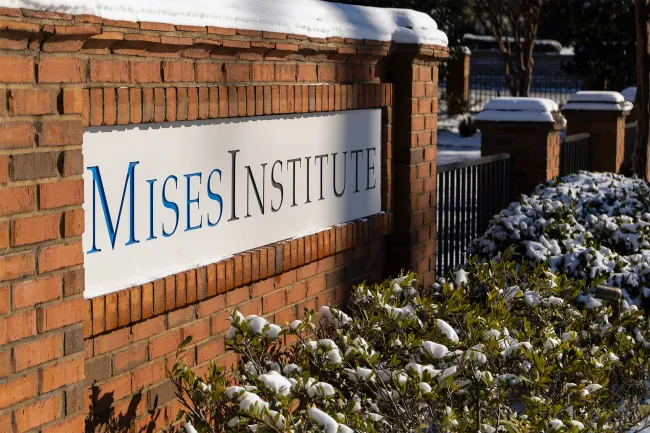Remember when train travel was glamorous? The 20th Century Limited—connecting New York and Chicago—epitomized luxury in 1928. Yet, America’s passenger trains have lost money since 1946. To revive train travel, Congress created Amtrak in 1971. Fast forward to today, and this experiment has failed. Politicians have chosen routes to win votes rather than attract passengers. As a result, Amtrak has been squandering taxpayer subsidies for 54 years.
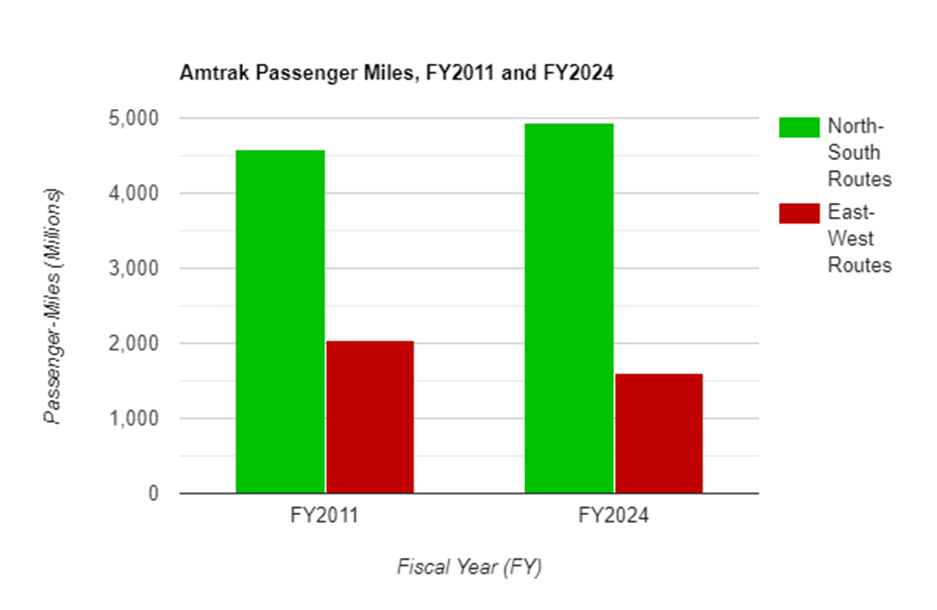
Figure 1. Passenger Miles, FY2011 and FY2024.
Since the invention of air conditioning, travelers have favored north-south routes. In FY2024 alone, Amtrak’s east-west routes lost over $560 million. Meanwhile, the Auto Train (Virginia to Florida) made a $6.6 million profit. Since FY2011, east-west passenger-miles have decreased by 22 percent. Yet, north-south routes have seen an 8 percent bump. In fact, travelers favor north-south routes over east-west routes by a ratio of three to one.
Between Chicago and Los Angeles, the Desert Wind lost less money than the Southwest Chief. Yet, Amtrak favored the Southwest Chief, which passed through more congressional districts. It discontinued the Desert Wind in 1997, leaving Las Vegas without train service. Today, the Southwest Chief still loses money. Its losses grew from $56.1 million in FY2019 to $83.3 million by FY2024. Since 2014, its decaying tracks have cost over $45 million in repairs.
Airlines are seeing the same trend. In the fourth quarter of 2023, the New York to Miami route saw 25,263 daily passengers—a 13 percent increase from 2019. Meanwhile, the New York to Los Angeles route saw only 13,213 passengers, a 10 percent drop.
Flixbus is focusing on north-south routes as well. It now offers six daily trips between Chicago and Atlanta, one more than in 2019.
Amtrak ignored profits under Democrats but now claims it will be profitable to win GOP votes. Despite reporting a $705.2 million loss for FY2024, this deceitful number excludes:
- $966.2 million in depreciation;
- $447.3 million in “Project Related Expenses”;
- $314.1 million in state subsidies;
- $26.9 million in Office of Inspector General funding
With its real costs factored in, the notion that Amtrak can ever turn a profit is a pipe dream. In fact, Amtrak is demanding greater subsidies than ever before. In 2021, Congress allocated $66 billion for passenger rail. Yet, Amtrak’s losses rose from $1.12 billion in FY2019 to $2.12 billion by FY2024.
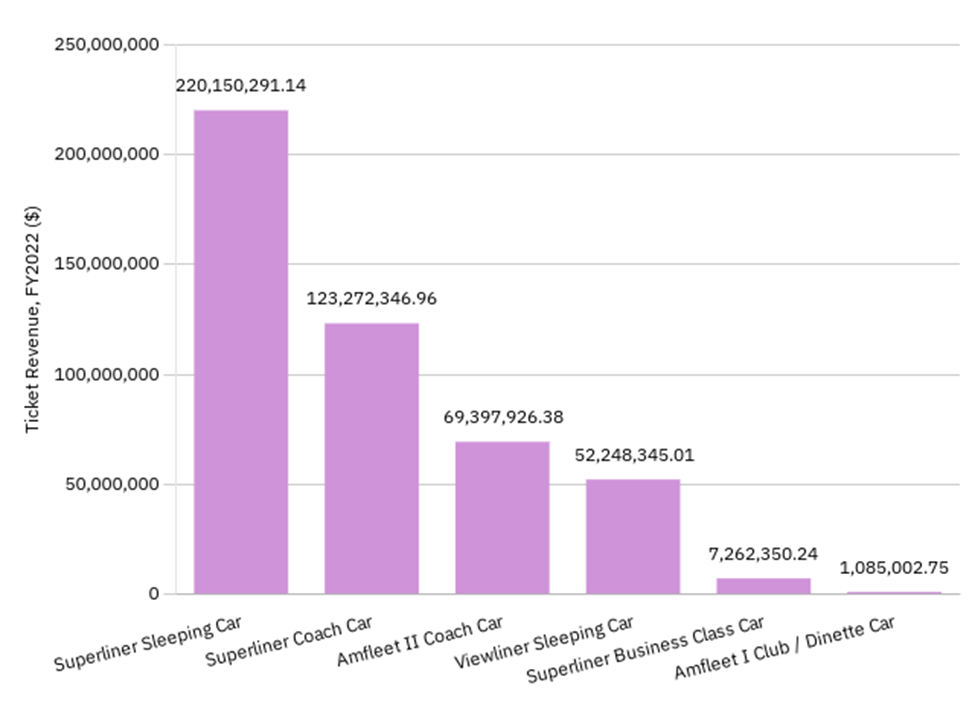
Figure 2. Ticket Revenue, Overnight Long-Distance Routes, FY2022. Independent rounding may lead to different figures.
Instead of cutting unprofitable routes, Amtrak blames long-distance routes. Meanwhile, state-supported routes under 750 miles are doing even worse. In FY2019, they were 41 percent full; by FY2024, that dropped to 38 percent. This is much lower than the 57 percent load factor of long-distance routes.
More people are working from home, leading to huge losses for state-supported routes:
- The Springfield to New Haven route was only 33 percent full, losing around $30 million in FY2024.
- The New York to Harrisburg route was only 28 percent full, losing over $42 million.
- The San Luis Obispo to San Diego route was only 29 percent full, losing over $65 million.
- The Oakland to Bakersfield route was only 24 percent full, losing over $70 million.
- Amtrak spent $2 billion to increase speed from Chicago to St. Louis. Yet, there are only a few more passengers aboard.
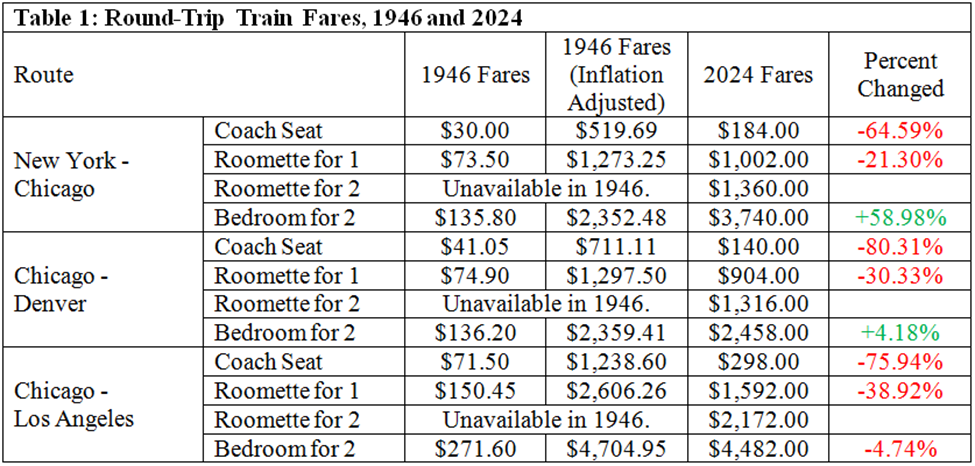
If short-distance trains fail, what about long-distance routes? Amtrak’s long-distance trains offer two classes: coaches and sleeping cars. Sleeping cars are more profitable, with fares comparable to those from 1946. Coach seats are hard to fill even when adjusted prices are 80 percent lower now.
The Ghan—a long-distance train in Australia—has cracked the code to profitability. The reason? It only offers sleeping cars, no coach seats. When the Ghan offered coach seats, it lost buckets of money. After discontinuing coach services in 2016, it became a thriving route.
By only using Superliner sleeping cars, Amtrak could operate without subsidies too. Potential routes include:
- Auto Train: Lorton to Sanford, daily.
- Champion: Hoboken to Miami, every four days; saving four to eight hours.
- Texas Chief: Hoboken to Houston, every four days; offering a one-seat ride.
- Panoramic: Hoboken to Los Angeles, every four days.
- Starlight: Vancouver to Los Angeles, every four days.
These scenic trips could offer a unique travel experience using existing rails. The problem is, Amtrak’s subsidies make it hard for all-sleeping car trains to compete. Take the Panoramic, for example. It can only work if Amtrak stopped operating these subsidized routes:
- Lake Shore Limited.
- Pennsylvanian.
- Cardinal.
- Southwest Chief.
Figure 3. Potential routes that could operate without either capital or operating subsidies.
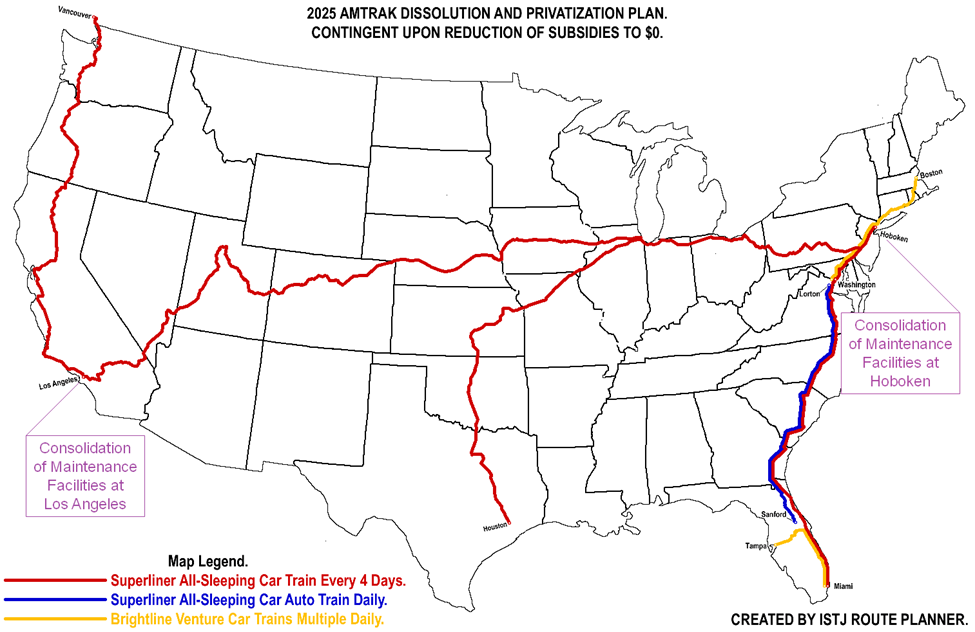
Why hasn’t Congress ended Amtrak subsidies? Advocates cite highway subsidies; yet, Amtrak guzzles 39 times more subsidies per passenger-mile. For FY2024, Amtrak touted ridership records on 17 out of 46 routes. Yet, 29 others saw declines, and passenger-miles have dropped 3.4 percent since FY2013.
For political reasons, Amtrak’s environmental benefits webpage is now gone. Some routes are efficient, but Amtrak won’t focus on them since it might cost votes.
Another common exaggeration is that highways and airports are bursting at the seams. For instance, the busiest airline route—New York to Miami—carries 25,263 daily passengers. It’s a notable number, but not indicative of widespread congestion along other routes.
Freight trains thrive without subsidies, so why shouldn’t Amtrak? Amtrak blames delays on freight trains, but often chooses questionable routes. For example, its route from Chicago to Miami takes 17 hours longer than it needs to.
Senators Jerry Moran (R-Ks.) and Martin Heinrich (D-N.M.) see Amtrak as “essential.” Yet, Amtrak accounts for a tiny fraction of travel. In fact, Americans travel more miles by bicycle than they do via Amtrak.
Even if Amtrak were to disappear, alternatives would be cheaper than subsidizing it. The average airfare in 2024 was around $0.29 per passenger-mile. This is much lower than Amtrak’s subsidies of $0.91 per passenger-mile.
Amtrak criticizes UK rail privatization because political influence remains. Politicians were still designing routes while private companies pocketed subsidies. Instead of emulating this model, Congress should cut Amtrak’s subsidies to $0. This would let train companies operate without political constraints.
Congress has exhausted ways to limit the growth of Amtrak’s subsidies since 1971:
- Clinging to routes that have lost money for 54 years is a sunk cost fallacy.
- Investing in “high-speed rail” won’t help. Ridership on the high-speed Acela train has decreased by 9.5 percent since FY2019. Meanwhile, slower Northeast Regional trains have seen a 21 percent increase in riders.
- Despite losing $2 billion in FY2023, Amtrak awarded $5 million in bonuses to leaders.
- After Siemens made political donations, Amtrak started buying its locomotives. These locomotives have small fuel tanks and need to stop more often for fuel.
- Changing Amtrak’s leadership won’t stop the pork barrel spending on Amtrak.
- Outsourcing routes won’t work, either, as taxpayers would still foot the bill.
- Train passengers can move to other states instead of using unprofitable routes.
The only way to stop politicians from playing favorites with routes is to eliminate subsidies. Political control over subsidies means that ending them would also end that control. Other “reforms” are unlikely to succeed, as they would still allow political interference.
Today, travelers often seek scenic and enjoyable train experiences. Brightline Florida—a privately-owned train service—began operating in 2023. Rocky Mountaineer offers amazing train trips without subsidies. If Amtrak can’t figure it out, someone else will.
It’s time for Congress to stop guessing which routes will succeed and cut subsidies to $0. The President should also veto any bill that subsidizes Amtrak. Finally, Congress should repeal the Infrastructure Investment and Jobs Act of 2021. This Act wasted $66 billion in capital and operating subsidies for passenger rail.

